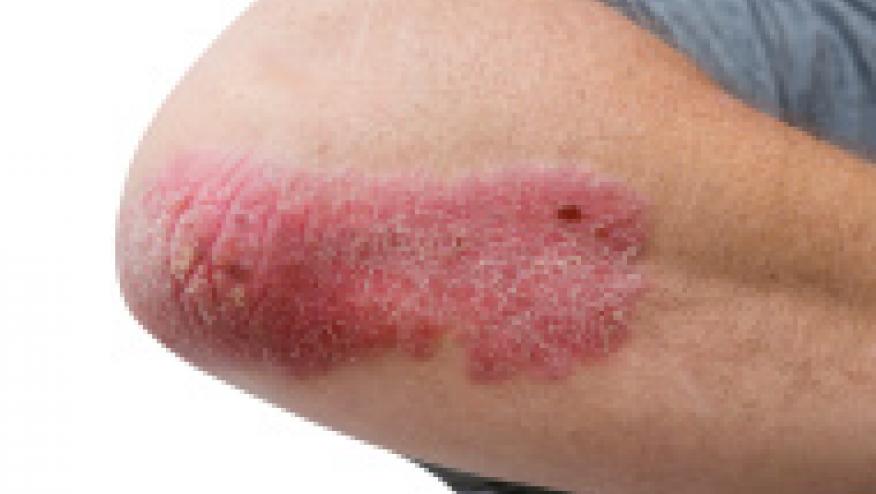From Psoriasis to PsA: Who and Why? Save

The number of patients with psoriasis who go on to develop psoriatic arthritis (PsA) is considerably higher than has previously been estimated, a prospective cohort study found.
Among patients enrolled in the Toronto Psoriasis Cohort, the annual incidence of PsA was 2.7 (95% CI 2.1-3.6) per 100, whereas an earlier study found a cumulative incidence of only 5.1% 20 years after the onset of psoriasis, according to Dafna D. Gladman, MD, of Toronto Western Hospital, and colleagues.
This suggests that "a significant proportion of psoriasis patients suffer from unrecognized PsA," the researchers observed online in Arthritis & Rheumatology.
Epidemiologic studies have demonstrated that most patients who develop PsA had the skin manifestations long before the joint involvement appeared.
"Therefore, patients with psoriasis may serve as a preferred target population for investigating the epidemiology of PsA and for identifying markers of high risk for the disease," Gladman and colleagues wrote.
"Such information may contribute to the understanding of the pathophysiology of PsA and can also be used to develop clinical prediction algorithms for dermatologists to identify psoriasis patients who are at high risk for developing PsA," they stated.
Previous retrospective and population-based studies have identified a variety of potential risk factors for the development of PsA among psoriasis patients, including severe skin disease, obesity, family history, and smoking, although those studies have been limited.
With the goal of clarifying the incidence and risk factors for PsA, the researchers followed the enrollees in their cohort for an 8-year period, with the current analysis focusing on those without arthritis at baseline.
All members of the cohort had dermatologist-confirmed psoriasis but no present or past inflammatory arthritis or spondyloarthropathy. A total of 464 were included in this study, with 51 cases of incident PsA being confirmed by a rheumatologist during a mean of 4.1 years of follow-up per patient.
At each annual assessment, a detailed musculoskeletal examination noted the presence of joint swelling and tenderness as well as dactylitis and enthesitis, and imaging analyses documented joint damage.
Among the entire cohort, the mean age at the time of enrollment was 47, and their mean duration of psoriasis was 16 years. In three-quarters, the psoriasis onset was before the age of 40. More than half were males.
The Psoriasis Area and Severity Index (PASI) was less than 10 in 86.9% but greater than 20 in 2.4% in the overall cohort, whereas 6.7% of the PsA subgroup were in the highest score group.
Among the PsA patients, arthritis was peripheral in 64.7%, axial in 17.6%, and both peripheral and axial in 15.7%, while enthesitis was present in 2%.
On radiographs or MRI, 41% of the PsA patients had detectable spondylitis or sacroiliitis, and among 39 who had radiographs of the hands and feet, 23% had at least one erosion.
On a univariate analysis, baseline factors that were associated with an increased risk of PsA were psoriasis severity, with a relative risk of 3.87 for severe disease and 1.35 for moderate disease (P=0.05), systemic retinoid treatment (RR 2.80,P=0.04) and nail pitting (RR 2.21,P=0.007).
In contrast, a higher level of education was protective, with relative risks of 0.36 and 0.54 for a college degree and high school completion, respectively (P=0.08).
On a multivariate analysis, significant associations were seen for disease severity, retinoid use, and low level of education:
- PASI >20 versus <10: RR 5.39 (95% CI 1.64-17.7,P=0.006)
- Use of systemic retinoids: RR 3.42 (95% CI 1.24-9.44, P=0.02)
- High school graduate: RR 0.30 (95% CI 0.09-0.99,P=0.049)
- College graduate; RR 0.22 (95% CI 0.08-0.62,P=0.005)
No association was seen for any other baseline variables including family history, smoking, obesity, diabetes, use of anti-tumor necrosis factor therapies, and nail abnormalities.
An additional multivariate regression model considered time-dependent covariates, and found nail pitting (RR 2.51, 95% CI 1.37-4.49,P=0.002) and uveitis (RR 31.5, 95% CI 5.06-195.8,P=0.0002) to be independent predictors of PsA risk.
These risk factors for PsA "can be classified into factors related to psoriasis phenotype (nail pitting, severe psoriasis, and use of systemic retinoids), extra-articular manifestations (uveitis), and demographics (low level of education)," Gladman and colleagues noted.
The association between severe, more extensive disease phenotype and PsA risk may reflect a higher degree of inflammation in some patients, particularly in the context of genetic or environmental background that could together act to trigger the arthritis.
"Alternatively, the larger affected body surface area may provide a wider port of entry for the skin microbiome to interact with the immune system, which may play a role in the development of PsA," the authors suggested.
The findings of this study imply that clinicians need to maintain a high index of suspicion and be on the alert for musculoskeletal symptoms in patients with psoriasis.
Limitations included the possible over-representation of patients with more severe, longstanding psoriasis and the relatively small number of patients.
Gladman and coauthors disclosed support from the Kembril Foundation, the Canadian Institutes of Health Research, and the Arthritis Society.
This article is brought to RheumNow by our friends at MedPage Today. It was originally published on November 17, 2015.







If you are a health practitioner, you may Login/Register to comment.
Due to the nature of these comment forums, only health practitioners are allowed to comment at this time.